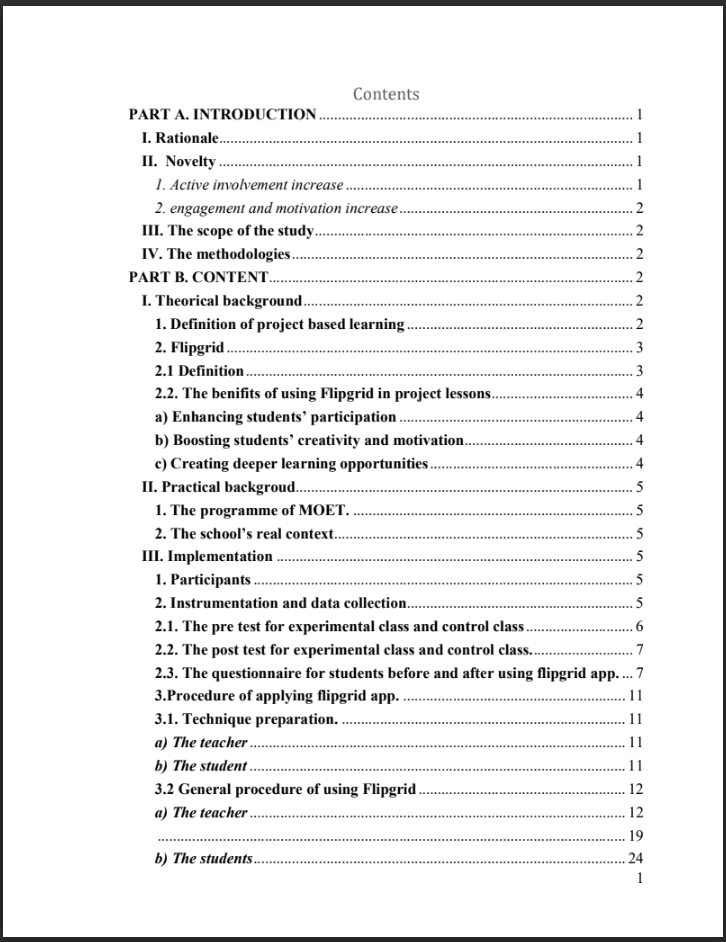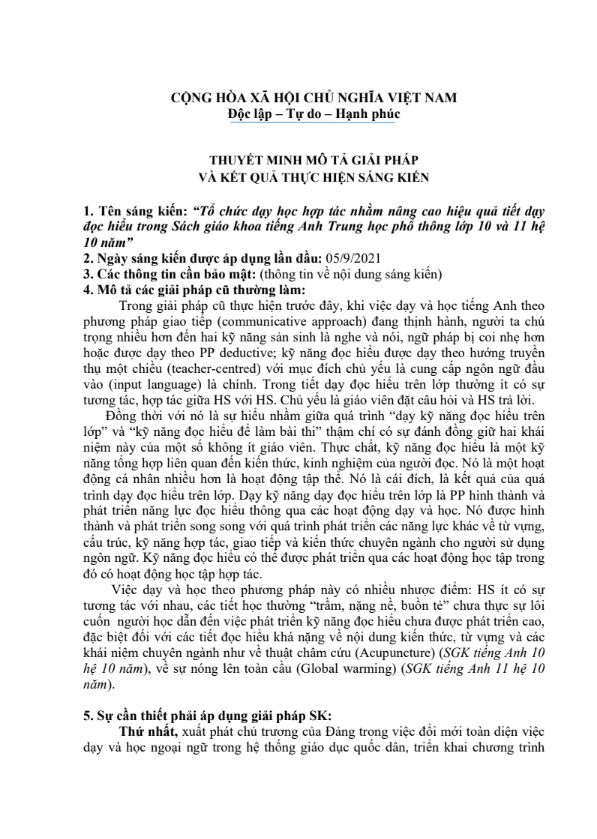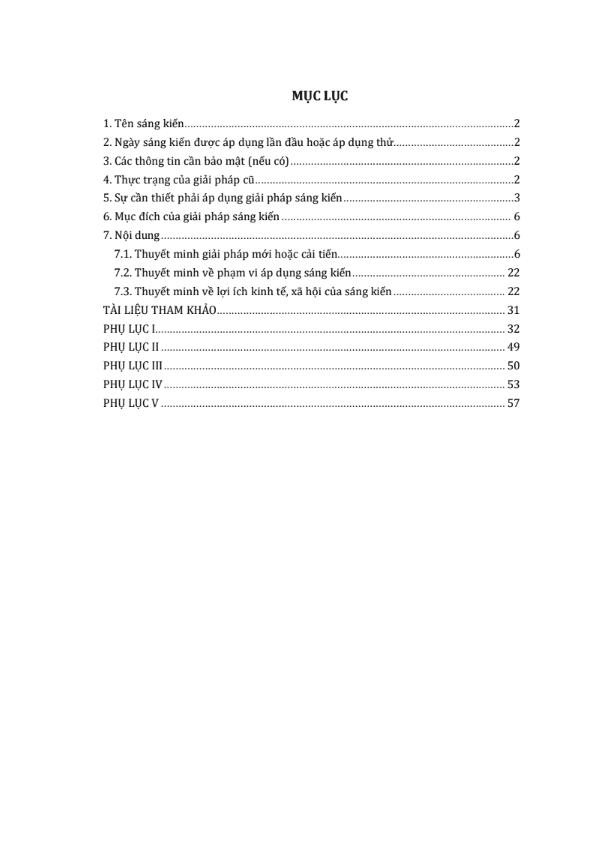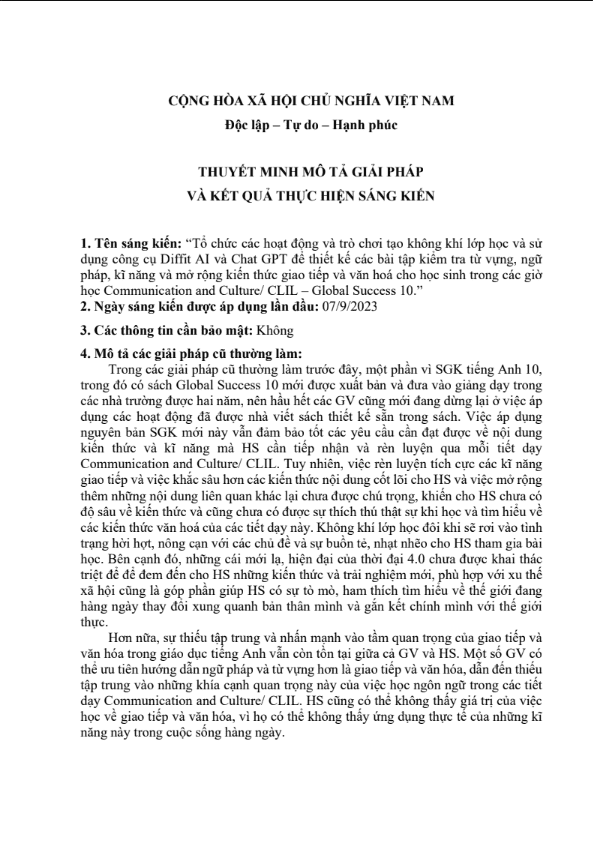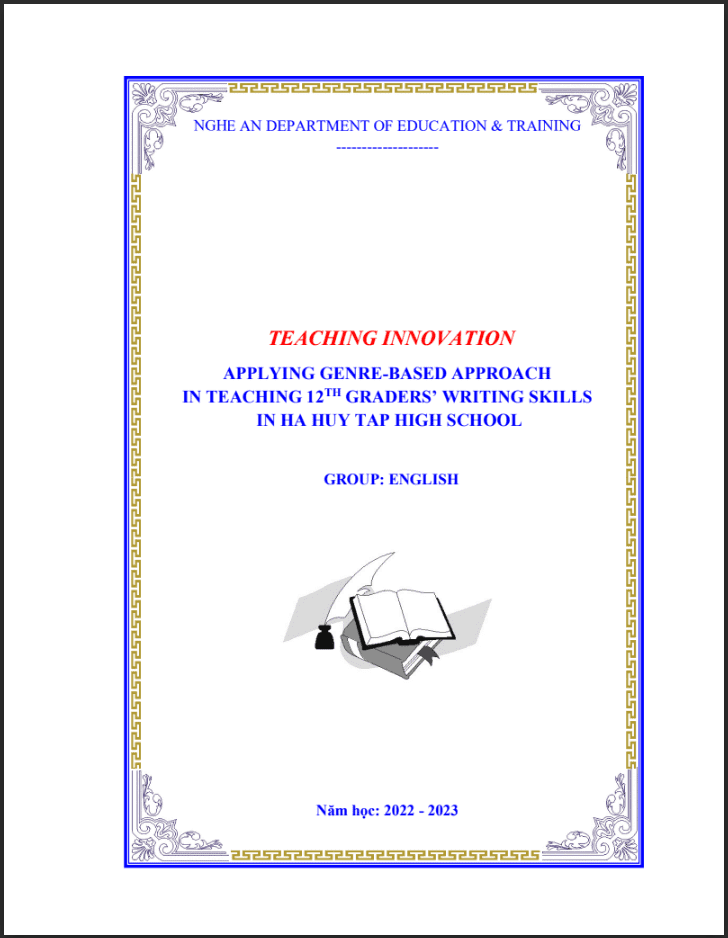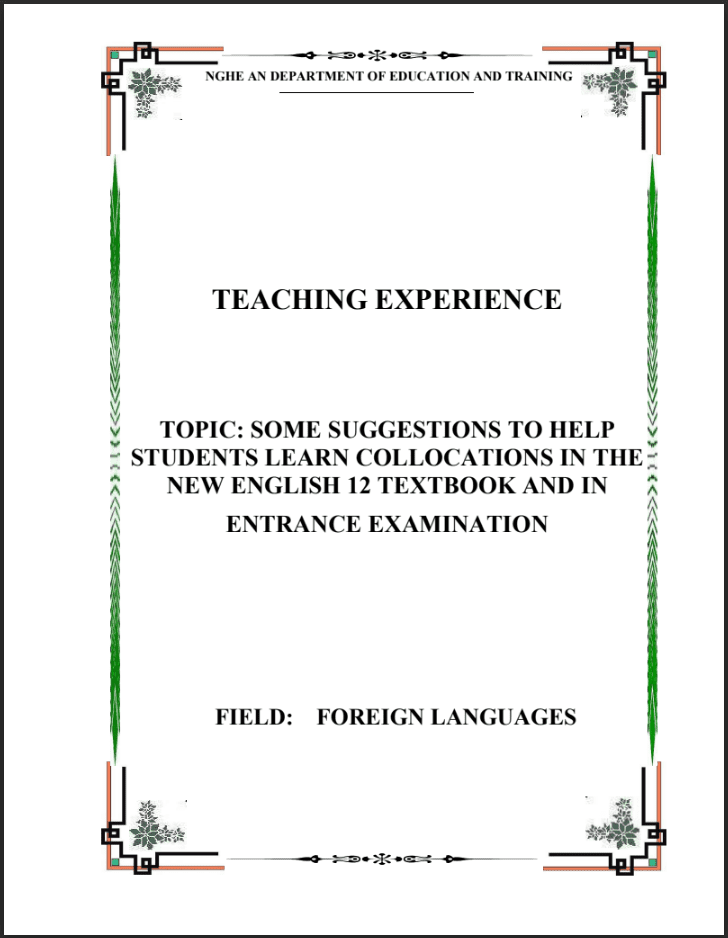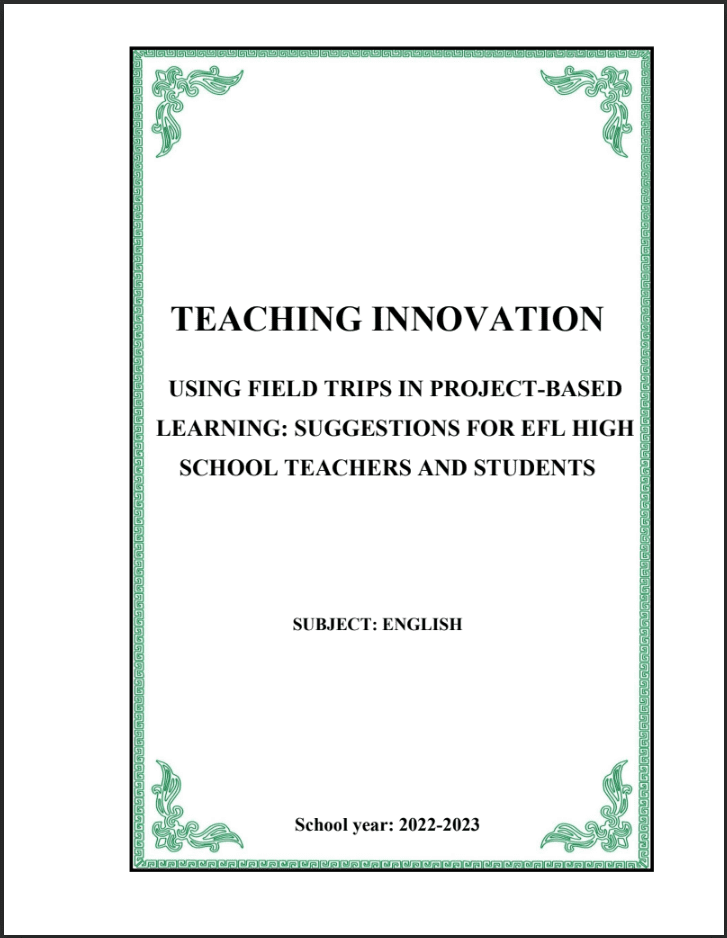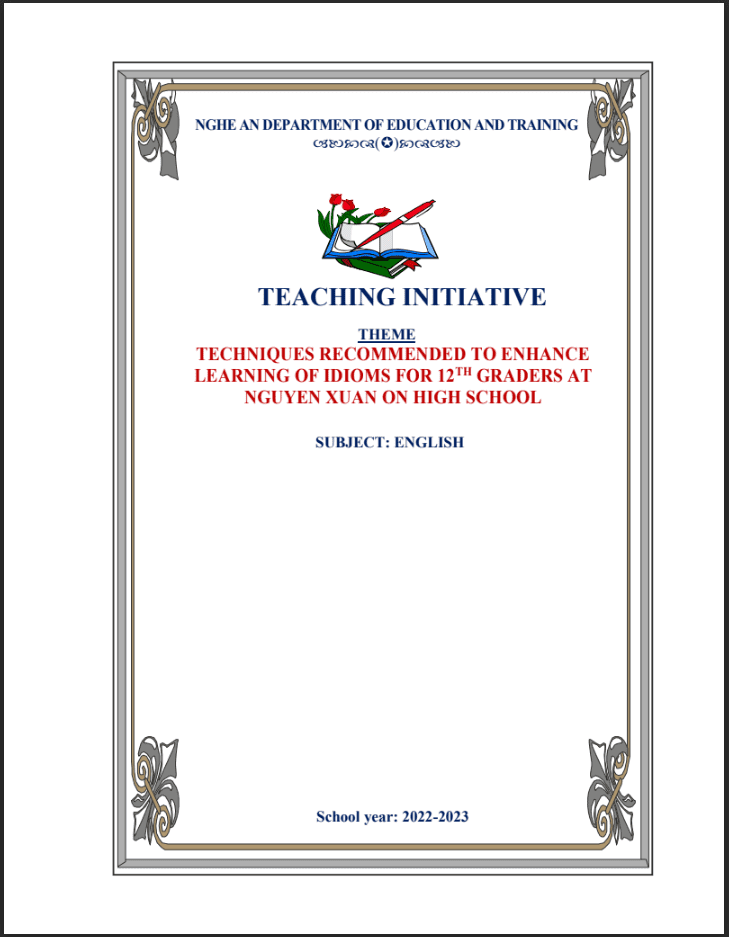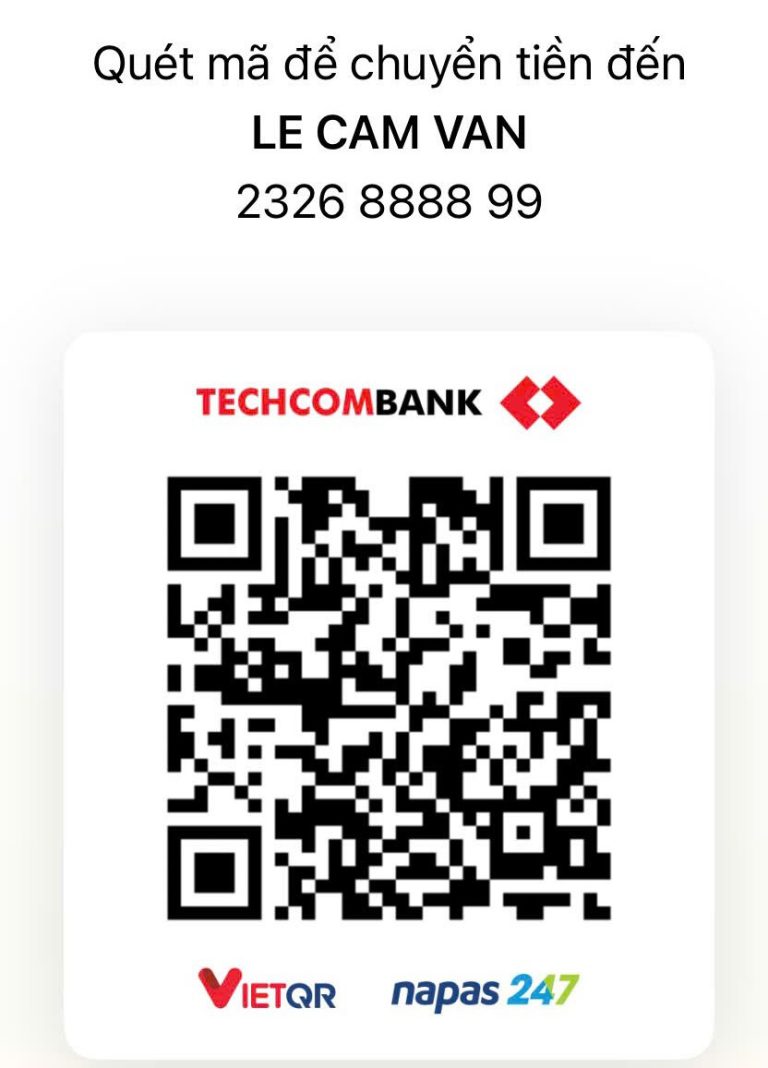SKKN Using -App fripgrid to maximize the effectiveness of the project lessons for 10th grade students
- Mã tài liệu: MP0096 Copy
| Môn: | Tiếng Anh |
| Lớp: | 10 |
| Bộ sách: | Global Success |
| Lượt xem: | 486 |
| Lượt tải: | 2 |
| Số trang: | |
| Tác giả: | Phạm Thị Mỹ Hạnh |
| Trình độ chuyên môn: | Cử nhân đại học |
| Đơn vị công tác: | THPT Thanh Chương 1 |
| Năm viết: | 2022-2023 |
| Số trang: | |
| Tác giả: | Phạm Thị Mỹ Hạnh |
| Trình độ chuyên môn: | Cử nhân đại học |
| Đơn vị công tác: | THPT Thanh Chương 1 |
| Năm viết: | 2022-2023 |
Sáng kiến kinh nghiệm “Using -App fripgrid to maximize the effectiveness of the project lessons for 10th grade students”triển khai gồm các biện pháp nổi bật sau:
Mô tả sản phẩm
PART A. INTRODUCTION
- Rationale
The current situation of English teaching and learning in high schools in Vietnam
mainly focuses on grammar and has the nature of dealing with exams. Therefore,
most of the students cannot communicate even if they get good marks on the school
tests. Faced with this situation, in order to teach and learn the project lessons, I
initially asked them to record videos of the talking to send privately to teachers via
channels such as email, messenger or Zalo. However, I found that this approach
doesn’t really work. Firstly, with such a large number of students, it is not possible
for teachers to review and comment on all students’ speech. Second, the videos are
sent exclusively to teachers through the above channels, so it is not systematic, and
at the same time, only the student can learn for himself after receiving feedback from
the teacher. Third, other students in the class have not yet seen the enthusiasm of
other students to be inspired, strive and learn from their classmates.
After using some methods, I discovered an app that helped improve speaking skills
for learners in project lessons and chose to use Flipgrid. I go to
https://info.flipgrid.com/ to create an account, create groups by class name, and
create unit-specific topics. I myself have experimented as a learner to return to my
presentations, thereby seeing the advantages of Flipgrid in project lessons and
guiding students to use in learning English.
For the above reasons, the writer decided to choose “using -App fripgrid to
maximize the effectiveness of the project lessons for 10th grade students” as the
teaching experience.
- Novelty
1
. Active involvement increase
Up until this point, numerous classes have been centered on teacher-centered
activities at many conventional schools, particularly in rural and mountainous areas.
During these times, either students are made to listen or they are passive listeners
who appear to ignore the learning process. Actually, a very small percentage of
students actively participate in their classes and are eager to learn. This unfortunate
reality has long existed in many colleges, universities, and schools because neither
students nor teachers are willing to adopt new, cutting-edge teaching and learning
techniques.
Flipgrid is a free platform where students can create and post short videos of
themselves responding to questions or topics. You can also choose to enable (or
disable) a feature that allows students to view and comment on their classmates’
videos.
1
While fostering classroom community and student-to-student relationships can be
difficult through a screen, Flipgrid helps bridge this gap.
2
. engagement and motivation increase
Flipgrid is great for blended and personalize learning and increasing student
engagement and motivation. Using English through conversation patterns as well as
traditional exercises will not interest students. Using the app “Flipgrid” will make
students more interested when they can use the tools on the app to make videos.
Students can discuss questions and topics on it without being limited in space or
time.
III. The scope of the study
With the aim of maximizing the effectiveness of project lessons for 10th grade
students at Thanh Chuong 1 high school, a survey was conducted to collect the
needed data from the learners. 88 students of 2 classes from Thanh chuong 1 high
school in Nghe An province were involved in this study.
- The methodologies
–
The study used the pre and post tests to analyze the data, and verify the
results of using -App Fripgrid to maximize the effectiveness of the project lessons
for 10th grade students.
–
Questionaires are used to survey students’ motivation and participation before
and after using flipgrid app.
PART B. CONTENT
- Theorical background
1
. Definition of project based learning
The Project-based learning has been part of the educational practice approximately
at the beginning of the 1980s and it was greatly influenced by the communicative
approach. Nowadays, as an appropriate and effective method, it is widely used in
the teaching of English as a foreign language.
The history of PBL can be traced back to the progressive tradition advocated by John
Dewey. Dewey insisted on the idea of “learning by doing”. He argued that the
classroom should be a kind of society and the students should be encouraged to
become the center in the learning process.
Legutke and Thomas (1991) define project work as a learner and task-centered mode
of teaching and learning which results from a joint process of discussion between all
participants.
Project is an extended task which usually integrates language skills through a
number of activities (Hedge, 1993) . It involves a number of features: the use of
authentic English language materials, an emphasis on integrity and student-centered
activities, the importance of students’ participation and the use of different skills. It
2
is also defined as “an instructional approach that contextualizes learning by
presenting learners with problems to solve or products to develop” (Moss & Van
Duzer, 1998) . Project work encourages creativity, critical thinking, collaboration,
self-study, and other study skills.
Project-based learning is a very effective approach that allows the students to throw
out opinions about the topics covering fields of interest, to ask questions, to estimate,
to develop theories, to use different tools, to use the skills acquired in the context of
a real and meaningful life and allows learner to solve problems and answer questions
in a creative way in the classroom and outside (Katz & Chard, 2000) .
Thomas’s adopts five criteria to define PBL: 1) “Projects are central, not peripheral
to the curriculum”; 2) “projects are focused on questions or problems that ‘drive’
students to encounter (and struggle with) the central concepts and principals of the
discipline”; 3) “projects involve students in a constructive investigation”; 4)
“projects are student-driven to some significant degree”; and 5) “projects are
realistic, not school-like”. Collaboration, as a matter of fact, should also be included
as a sixth criterion of PBL (Thomas & Mergendoller, 2000) .
Stoller (2006) defines PBL as: 1) having a process and product; 2) giving students
(partial) ownership of the project; 3) extending over a period of time (several days,
weeks, or months); 4) integrating skills; 5) developing students’ understanding of a
topic through the integration of language and content; 6) collaborating with other
students and working on their own; 7) holding students responsible for their own
learning through the gathering, processing, and reporting of information from target
language resources; 8) assigning new roles and responsibilities to students and
teacher; 9) providing a tangible final product; and 10) reflecting on both the process
and the product. Thus, it is different from the traditional English teaching in that it
lays great emphasis on the communicative and functional aspect of language
learning and it also pays attention to the integrity of language and content learning.
It is obvious that the definition of PBL is changing from time to time. This diversity
of defining features coupled with the lack of a universally accepted model or theory
in Project-based learning has finally led to a variety of PBL researches and
development activities, which rendered great complexity to this issue. Fortunately,
there are still some overlaps in these design features.
2
2
. Flipgrid
.1 Definition
Flipgrid is a social learning platform that allows educators to ask a question either
through a video or voice recording, then the students can respond in a video or voice
recording. Students can write comments in Flipgrid where the teacher or students
created videos. This web of discussion creates an online community where
knowledge is shared and created.
3
The purpose of this study is to evaluate the efficacy of utilizing ‘Flipgrid,’ a PC and
mobile device video recording and social media application, as a means of practice
in an English communication class. The present small-scale study was conducted at
a Thanh Chuong high school in. The practical implications of this study inform on
innovative ways to improve communicative English engagement in higher learning
education. In this case, student presentation videos and online video discussion tasks
were recorded using the Flipgrid application on student smartphones. The data
collection methods consisted of teacher observations, video data and student
responses recorded via a questionnaire.
2.2. The benifits of using Flipgrid in project lessons
Ever since its launch in 2014, Flipgrid has quickly become a widely used tool by
teachers and students worldwide, and for a good reason. By integrating such a fun
and exciting platform in their classroom, teachers expose their students to new ways
of learning and interacting in class. Here are some of the benefits of using Flipgrid
in the classroom:
- a) Enhancing students’ participation
Students interact with one another through Flipgrid by using videos as their primary
tool. The app allows students to record their responses as many times as they need,
and when they feel comfortable with one version of their response, post it. They
have more time and space to give their take on a discussion after using sufficient
time and space to record their answer. Therefore, students can interact with the class,
and while others can still see and hear them, the pressure of being there living in the
classroom is gone.
- b) Boosting students’ creativity and motivation
Secondly, using video recordings, texts, emojis, stickers, and other features on
Flipgrid is always more than welcome for students who are growing up using
technology and social media in their everyday lives. Videos make the learning
process more attractive and give already engaged student opportunities to be more
creative and, to the more reserved ones, the opportunity to express themselves.
Ultimately students will focus all their energy and attention on learning through
participation instead of being anxious.
- c) Creating deeper learning opportunities
Lastly, but perhaps most importantly, Flipgrid eliminates the anxiety and stress
associated with participating in a class discussion and gives students a chance to be
more engaged. For example, instead of reading a textbook and becoming acquainted
with a new culture, students in one country can interact with students worldwide and
get the information they need firsthand. By constantly participating and contributing
to class discussions, they have a hands-on, more profound learning experience – thus
increasing information retention.
TÀI LIỆU LIÊN QUAN
- 7
- 105
- 1
- [product_views]
- 5
- 173
- 2
- [product_views]
- 4
- 165
- 3
- [product_views]
- 4
- 129
- 4
- [product_views]
100.000 ₫
- 6
- 434
- 5
- [product_views]
100.000 ₫
- 2
- 507
- 6
- [product_views]
100.000 ₫
- 9
- 546
- 7
- [product_views]
100.000 ₫
- 4
- 409
- 8
- [product_views]
100.000 ₫
- 2
- 595
- 9
- [product_views]
100.000 ₫
- 0
- 538
- 10
- [product_views]

